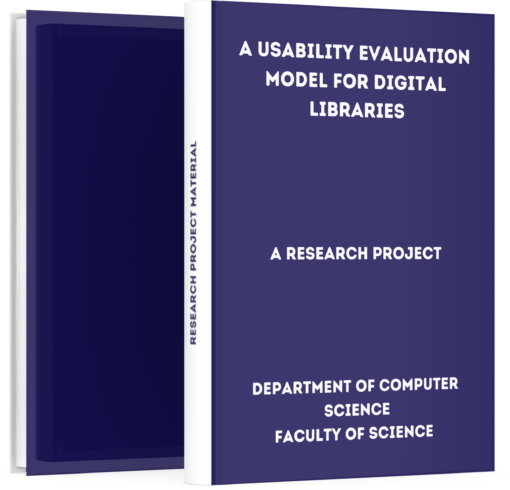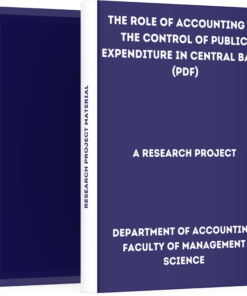A Usability Evaluation Model for Digital Libraries
₦3,000.00
If you are interested in getting this project material “A Usability Evaluation Model for Digital Libraries”, click on the DOWNLOAD BUTTON to make payment and the file will be delivered to your email immediately after confirmation.
Description
– A Usability Evaluation Model for Digital Libraries –
Download A Usability Evaluation Model for Digital Libraries. Students who are writing their projects can get this material to aid their research work.
Abstract
Usability is the extent to which a product can be used by specific users to achieve specified goals with effectiveness, efficiency, and satisfaction in a specified context of use. The Nielsen’s usability model has been popularly used for system usability evaluation.
This thesis introduces a modification to Nielsen’s usability evaluation model which was used to evaluate the usability status of digital libraries in tertiary institutions in Lagos State. The digital libraries used were that of University of Lagos, Lagos State Polytechnic and Federal College of Education, Akoka.
This modified model incorporates four traditional attributes (Efficiency, Effectiveness, Satisfaction, Learnability) and two additional attributes (Discoverability and Cognitive Load) introduced by the researcher;
these two attributes were introduced because they have been proven to be user centered attributes which will help in getting the users’ personal experience while using the software (digital library) unlike the existing usability evaluation models which were majorly system centered.
The digital libraries will be assessed using modified heuristic think aloud method. The study employed purposive sampling technique to select the three tertiary institutions that was used for the evaluation while Yaro Yamani formula was used to calculate the users’ population sample size of (40) for each of the institution.
Six task based questionnaires were used to carry out test in collecting data for the study; they include: (i) Discoverability test, (ii) Cognitive Load test (iii) Learnability test (iv) Effectiveness test (v) Efficiency test and (vi) Satisfaction test.
The mean of each of the usability attributes were used to evaluate the usability status of the digital libraries of the selected institutions. IBM SPSS statistics version 21 was used to calculate the mean.
Introduction
1.1 Background of the Study
The world has become a global village where information technology is used in all spheres of human activity to record, store, and disseminate information in the digital form.
The new generation whose demand for information is insatiable is always demanding that traditional libraries be developed as a well-equipped and interconnected as digital libraries. Information and Communication Technology has revolutionized the concept of libraries such that libraries are gradually becoming digitized.
A digital library comprises digital collections, services and infrastructure to support lifelong learning, research, scholarly communication as well as preservation and conservation of our recorded knowledge. It is also a process of democratization of information.
According to Arms (2012) a digital library is a managed collection of information with associated services where the information is stored in digital format and accessible over a network.
A digital library is an organized collection of digitized material or it’s holding in the digital form, which can be accessible from digital devices on the network using Transmission Control Protocol/Internet Protocol (TCP/IP) or other protocol.
In digital library high speed optical fiber are used for Local Area Network (LAN) and the access is over Wide Area Network (WAN) and provide a wide range of Internet based services including audio and video conferencing and others.
Lynch (2013) opined that digital libraries provide users with coherent access to a very large, organized repository of information and knowledge.
According to the Berkeley Digital Library Project, University of California (Wilensky, 2012), the digital library will be a collection of distributed information sources.
Some of the requirements for digital libraries are: Audio visual (T.V, V.C.R, life theatre and D.V.D), Computer, Network connectivity, Printer, Scanner, Storage devices, Software. Digital libraries have features such as:
Incorporating learning and access, provides fast and efficient access to information, with multiple access modes, collections which are large and persistent over time, well organized and managed.
How to Download this Project Material
First, note that we are one of the best and most reliable online platforms because we don’t retain any of your personal information or data as regards making payments online.
PRICE: ₦3,500 ₦3,000 (Three Thousand Naira Only)
Make a bank deposit or mobile transfer of ₦2,000 only to the account given below;
Bank Name: UBA Account Number: 1022564031 Account Name: TMLT PRO SERVICES
After making the payment, CLICK HERE to send the following on WhatsApp;
- Depositor’s Name or Screenshot of Payment
- Name of the Past Question
- Active Email Address
or Call Us On +2348082284439 Once your details have been received and your payment confirmed by us, you will receive the past question in your email or WhatsApp within 5 Minutes.
Guarantee of Getting the Material
We understand that due to the high rate of fraud, many people are afraid of making purchases online but be rest assured that PastExamQuestions will deliver your material after payment.
Once your details have been received and your payment confirmed by us, you will receive the past question in your email or WhatsApp.
Give us Feedback
Have we been able to satisfy you? How well do you think the material will be helpful after having gone through it? Does the price worth the material?
Let’s hear from you! We recommend that our customers give feedback at the end of every transaction to enable us to serve better. You can do this by clicking the review button on this page.
Where is the review button? >> Just scroll up to where you see reviews





Reviews
There are no reviews yet.